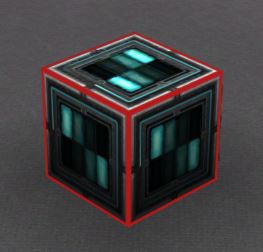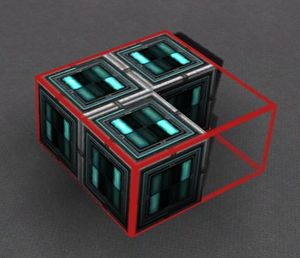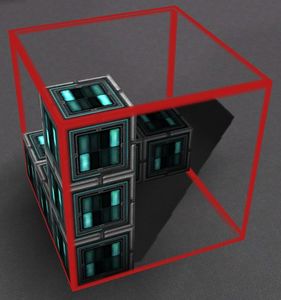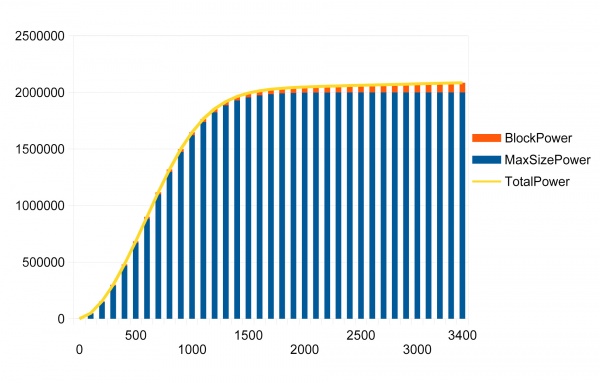Legacy Power Systems
(Redirected from Power Systems)
| Legacy Power Systems is no longer in-game.
Information on this page is no longer relevant in-game documentation in current versions of StarMade. The page Legacy Power Systems is for historical purposes only. |
For information on the current system of power generation in Starmade, see Reactors.
This page describes the old, first-run model for power generation and storage mechanisms in StarMade and is no longer used. Data from this test version was used to design and implement Starmade's current power system, Power 2.0.
Contents
Power Generation and Storage Blocks
Power is generated using either Power Reactor Modules or Power Auxiliaries, although the latter is greatly preferable as a supplement to the former (when they have reached or surpassed their peak efficiency), not a replacement. Entities built from a Ship Core have an innate power regen rate of 1 power per second (commonly abbreviated as "e/sec"). Planets and Space Stations do not have this innate power generation. Ships also have a base power capacity of 50,000 energy (as with regeneration, planets and stations have no innate power capacity). Power capacity can be increased using Power Capacitors. All three types of power blocks are more efficient (in terms of power per second per block, or e/sec/block) when placed in particular configurations, as detailed in their sections below.
An important consideration is that all systems drain some amount of power from the ship's capacity, either at a constant rate for a period of time (passive effects, scanner and jump drive charging, or cloaking and jamming), or in instantaneous bursts of varying frequency (most weapons). If the instantaneous power cost of an action (eg. firing a large missile) is greater than the power capacity of the ship, the action will not occur, a "Power Failure" warning will appear below the targeting reticle (as well as a red "E" in a triangle, at the top of the screen), and no power will be drained for that action. In most situations, a ship should at least have sufficient capacity to fire one salvo of its alpha (high damage, long cooldown) weapons. Power capacity should usually also include leeway for power spikes caused by shield regeneration costs, thruster activation, and potentially even enemy EMP attacks (which can cause significant power drain if the attacking ship is focussed on such weaponry).
Power generation will ideally be greater than the maximum expected rate of power usage: failing this, there should be a great enough combination of capacity and regen that the ship will not rapidly drain its capacity if power drain exceeds normal levels. For example, although very few large ships have regen equal to the power demand of charging a large Jump Drive, their capacity is usually greater than the cost to charge the drive.
A further consideration for larger ships is the use of Power Auxiliaries. These blocks are not more useful than Power Reactor Modules until the latter has reached its peak efficiency (as detailed below, this is approximately 2,000,000 e/sec). After this point, the output of Power Reactor Modules peters out, making way for Power Auxiliaries. They have a similar "soft-cap", but this is per physically separate group, rather than a cap placed on a ship as a whole. However, when a block in a given group of them is destroyed, that group will be affected by a series of explosions, proportional to the size of the affected group. Because of this, they serve as a useful, if risky, way for large ships to further increase power generation.
Power Reactor Rules
Power Reactors have some relatively complex rules governing their power output, especially if one is concerned about efficiency (either in terms of power per block, or power per volume). Two separate formulas are used: one which deals with the output of a single group of reactors (which is only used when the ship has exactly one reactor group), and one which is used to calculate the total output of multiple separate groups on a ship.
Single Group Formula
The formula for an entity with exactly one Power Reactor group is as follows:
GroupPower = BlockPower + SizePower
where:
BlockPower = 25 * NumberOfBlocks
and:
SizePower = 2000000 * 2 / ( 1 + 1.000348-0.333*(SumOfDimensions/3)1.7) - 2000000
GroupPower is the sum of the following values.
BlockPower is the base power per second per block of Power Reactors: 25e/sec/block.
SizePower is an extra power value dependent on SumOfDimensions: the sum of dimensions of the minimum bounding box for a given reactor group. SumOfDimensions, of course, is not dependent on aspect ratio: a 3x3x3, 1x1x7, and 2x2x5 bounding box all have a SumOfDimensions of 9. SizePower is of the greatest importance to efficient reactor design as it is an exponential function, and every successive increase in SumOfDimensions has greater value than the last.
Note that SizePower has a maximum value of 2,000,000e/sec, and suffers from diminishing returns as it approaches this value. Also note that for multiple reactor groups, the above formula is modified, and results in a diminishing return to TotalPower. TotalPower of an entity is not the sum of the GroupPower of each group. See the Multiple Group Formula below, as well as the Advanced Analysis section, for a more detailed explanation of the equation.
Here are some examples of power reactor groups and how their power outputs are calculated.
- Example power reactor groups and power values
Multiple Group Formula
When there is only one power reactor group on an entity, the GroupPower of that reactor is equal to the total power regen of the entity. However, when there is more than one group, the total power regen of the entity is not the sum of the GroupPower of all groups. Rather, TotalPower of an entity with multiple power reactor groups is subject to diminishing returns, and is given by the following formula:
TotalPower = BlockPower + GroupSumSizePower
where:
BlockPower = 25 * TotalNumberOfBlocksInAllGroups
and:
GroupSumSizePower = 2000000 * 2 / ( 1 + 1.000348-0.333 * GroupSumPower) - 2000000
where:
GroupSumPower = (SumOfDimensionsOfGroup1/3)1.7 + (SumOfDimensionsOfGroup2/3)1.7 ... + (SumOfDimensionsOfGroupn/3)1.7, where n is the number of groups.
These formulas are displayed on the following Desmos graph.
Optimal Layouts
- Optimal maximum-output layouts
Every group pictured above (excluding the 3x3x3 "cubic reactor") consists of 20 blocks arranged in an optimal pattern. An optimal pattern for a group is one in which every block increases SumOfDimensions: this of the utmost importance to creating efficient (high power per second per block) reactors. Note that, though not pictured above, a straight line of Power Reactors is also a maximum-efficiency layout for a given block count. This is because each block increases SumOfDimensions, providing the maximum SizePower for the group.
The goal in design of a ship's power generation should be to both maximize every group's box dimensions (netting the greatest e/sec/block efficiency) while also reserving large contiguous volumes within the ship for other systems, as well as rooms of both functional (core room and access routes) and non-functional (miscellaneous roleplay/decorative rooms) nature.
Outdated "cubic reactors", in which many small groups are tightly packed into a small cubic volume (5x5x5 being particularly common for this type), have a comparatively low e/sec/block value, and are not recommended under any circumstance. They are only an academic excercise, one used when the above formulas were first being uncovered and tested.
The key points, therefore, of efficient reactor design are:
- For over 9 or more power reactor modules, build the largest optimized single group possible within the volume of the ship, using perpendicular 1-block wide bars. (A single group up to around 1400 to 1800 blocks, or around 2 million e/sec, is about the ideal for large ships). 'Optimized' means that every Power block in the group will increase the SumOfDimensions. Simply placing long straight lines or 3-axis crosses is common, due to the simplicity of the shapes. If the ship is too small to build a single 2-million e/sec reactor, then build a second or third, depending on the volume of the ship and the power desired for that ship.
- For 8 or fewer power reactor modules, it is optimal to build in disconnected single blocks.
- The exceptions to not increasing the Sum-Of-Dimensions of a contiguous block group with every block should only be when taking a detour around other systems or another power block group.
- Once the first (and usually largest) group is placed, it is likely for smaller ships that more groups will be required to reach the desired e/sec output. For medium-sized ships, one group that maximizes the Sum-of-Dimensions within the available volume of the ship will likely not produce as much power as desired. Space permitting, then add in as many more parallel groups which each maximize the sum-of-dimensions within the remaining space.
- Where possible, run separate groups along the same path as the primary group, ensuring that they are not connected face-to-face at any point. Since the first group should have maximized the sum-of-dimensions in the available volume, a parallel group would generally be the best possible shape for the second group, depending on available ship volume.
- Diagonal adjacency (that is to say, adjacent edges, rather than adjacent faces) is normally preferable. This would result in interior block cavities in some cases that could be filled with power-capacitors, for example.
- Bear in mind that 1-block groups produce 140e/sec, compared to the 25e/sec that redundant blocks in a group will add. Therefore, if eking out more power, fill internal spaces with small, separate groups, rather than connecting more blocks to an existing large group, redundantly; the latter is likely to produce significantly less TotalPower for the number of blocks used.
- 'Redundant' in this case means blocks that do not increase the Sum-of-Dimensions. An 'L' shape is optimal because all blocks each increase the sum-of-dimensions. Making a double-thick 'L' or a hollow square out of the 'L' shape almost doubles the blocks, but results in two sides of the square being all redundant blocks that only contribute 25 e/sec each. Better to make two unconnected 'L' shapes, not a square or double-wide 'L'.
- The power output from Power Reactor Blocks hit peak efficiency at 895 blocks and hit diminishing returns at around 1,200 to 15,00 blocks. Power Auxilaries are are 19.87% more resource intensive to build and usually less efficient. Once you reach 14,710 Power Reactor blocks in a single group, it becomes economical to, switch to adding groups of 10,000 Power Auxiliary blocks. Power Auxiliary blocks are most efficient in groups of 10,000 (really 9890) blocks.
Power Auxiliary Rules
Power Auxiliaries add a separate auxiliary power pool to a ship, and gradually refill this over time when off. This pool can be stored up and then emptied into the main power pool for emergency recharging, or if the auxiliaries are left on, they will provide a constant boost to power generation. They should only be used once Power Reactor Modules have reached or surpassed their peak efficiency. They also provide a new element of risk to manage during ship design, as the chain reactions caused by destroying part of a Power Auxiliary group can be significant if not well-mitigated.
- Main article: Power Auxiliary
Power Capacitor Rules
Power Capacitors have a simple exponential equation governing their capacity.
GroupPower = 1000 * NumBlocks1.05
Note that the only variable is NumBlocks (total block count of the grouping). Since GroupPower is an exponential function, subsequent blocks provide greater increments than the ones before them. This increment is labelled "BonusPerBlock" in the table below. Because of this, the ideal configuration for any number of Power Capacitors is a single physically-contiguous group. Even if there are separate "clumps" or concentrations of blocks, all of these should be connected by thinner lines of capacitors, to ensure maximum output. It is also advisable to have redundant connections between clumps, to avoid the potential for battle damage breaking these connections.
Here are some sample group sizes and their value breakdowns. Note that values are rounded.
| NumBlocks | GroupPower | BonusPerBlock |
|---|---|---|
| 1 | 1,000 | 0 |
| 2 | 2,071 | 35 |
| 3 | 3,169 | 56 |
| 4 | 4,287 | 72 |
| 5 | 5,419 | 84 |
| 6 | 6,562 | 94 |
| 7 | 7,715 | 102 |
| 8 | 8,877 | 110 |
| 9 | 10,045 | 116 |
| 10 | 11,220 | 122 |
| 50 | 60,802 | 216 |
| 100 | 125,893 | 259 |
Power Reactor Advanced Analysis
This data is mostly of use for builders of large and very large ships. Even though a mid-sized ship might be able to make use of 2 million e/sec, it might not have the internal volume to make an optimized group of 800 or more power reactor modules. However, this analysis does show that small to medium ships should still try to utilize the largest optimized block structures that they can manage within the volume of their ship: this is always more effective than using outdated "efficient cube" reactor setups.
The following table lists the SizePower value generated by an optimal group of blocks of the given number. Note that the SizePower formula only asymptotically approaches its maximum value of 2,000,000 e/sec. At 3415 blocks, A one-decimal result rounds to 2 million.
| Blocks | Max SizePower | BlockPower | GroupPower | Power/Block Ratio |
|---|---|---|---|---|
| 25 | 4854.7 | 625.0 | 5479.7 | 219.2 |
| 50 | 14792.4 | 1250.0 | 16042.4 | 320.8 |
| 100 | 46492.6 | 2500.0 | 48992.6 | 489.9 |
| 200 | 148300 | 5000.0 | 153300 | 766.5 |
| 300 | 292236.1 | 7500.0 | 299736.1 | 999.1 |
| 400 | 469724.5 | 10000.0 | 479724.5 | 1199.3 |
| 500 | 671237.4 | 12500.0 | 683737.4 | 1367.5 |
| 600 | 885221.5 | 15000.0 | 900221.5 | 1500.4 |
| 700 | 1098666.6 | 17500.0 | 1116166.6 | 1594.5 |
| 800 | 1298843.6 | 20000.0 | 1318843.6 | 1648.6 |
| 895 | 1467322.0 | 22375 | 1489697.0 | 1664.5 |
| 900 | 1475480.8 | 22500.0 | 1497980.8 | 1664.4 |
| 1000 | 1622409.7 | 25000.0 | 1647409.7 | 1647.4 |
| 1100 | 1738002.7 | 27500.0 | 1765502.7 | 1605.0 |
| 1200 | 1824394.0 | 30000.0 | 1854394.0 | 1545.3 |
| 1300 | 1886032.9 | 32500.0 | 1918532.9 | 1475.8 |
| 1400 | 1928219.9 | 35000.0 | 1963219.9 | 1402.3 |
| 1500 | 1956037.9 | 37500.0 | 1993537.9 | 1329.0 |
| 1600 | 1973774.6 | 40000.0 | 2013774.6 | 1258.6 |
| 1700 | 1984741.6 | 42500.0 | 2027241.6 | 1192.5 |
| 1800 | 1991332.7 | 45000.0 | 2036332.7 | 1131.3 |
| 1900 | 1995189.4 | 47500.0 | 2042689.4 | 1075.1 |
| 2000 | 1997389.4 | 50000.0 | 2047389.4 | 1023.7 |
| 2100 | 1998614.2 | 52500.0 | 2051114.2 | 976.7 |
| 2200 | 1999280.1 | 55000.0 | 2054280.1 | 933.8 |
| 2300 | 1999633.8 | 57500.0 | 2057133.8 | 894.4 |
| 2400 | 1999817.6 | 60000.0 | 2059817.6 | 858.3 |
| 2500 | 1999911.0 | 62500.0 | 2062411.0 | 825.0 |
| 2600 | 1999957.5 | 65000.0 | 2064957.5 | 794.2 |
| 2700 | 1999980.1 | 67500.0 | 2067480.1 | 765.7 |
| 2800 | 1999990.8 | 70000.0 | 2069990.8 | 739.3 |
| 2900 | 1999995.9 | 72500.0 | 2072495.9 | 714.7 |
| 3000 | 1999998.2 | 75000.0 | 2074998.2 | 691.7 |
| 3100 | 1999999.2 | 77500.0 | 2077499.2 | 670.2 |
| 3200 | 1999999.7 | 80000.0 | 2079999.7 | 650.0 |
| 3300 | 1999999.9 | 82500.0 | 2082499.9 | 631.1 |
| 3400 | 1999999.9 | 85000.0 | 2084999.9 | 613.2 |
| 3415 | 2000000.0 | 85375.0 | 2085375.0 | 610.7 |
The above table is illustrated more effectively in the following chart:
- Graphs of SizePower and Total Power
It is easy to see that SizePower has diminishing returns after about 900 blocks. The precise number is 895. This is the number of blocks in a group that yields the maximum GroupPower per block, 1664.5, after which it begins to fall. If the groups were simply summed, then the ideal ship would have a couple of groups of about 895 blocks, or so. However, since the group formula introduces diminishing returns for multiple groups, it is best to use as few groups as possible, preferably one, if ship size permits. The asymptotic limit for SizePower at 2 million effectively soft-limits the number of blocks to around 1600-1800 due to diminishing returns. This effectively limits efficient ship power to around 2 million e/sec or so, in practice. The extra e/sec is not worth the doubling of power blocks to 3400 from around 1700 to gain a mere 50K. In fact, it might be better to roughly limit at around 1400 blocks or less. The first 400 blocks adds 469K e/sec to a ship. The last 400 blocks, from 1400 to 1800, only adds only about 73K e/sec. Consequently, large ships might be better served using those hundreds of blocks (or thousands if considering a higher +3K limit) in an Power Auxiliary system.
The table below illustrates the diminishing returns of multiple groups. To get to 2 million e/sec (using optimal layouts with each group):
| NumGroups | GroupSize | TotalBlocks | MaxSizePower | BlockPower | TotalPower | Power/Block |
|---|---|---|---|---|---|---|
| 1 | 1528 | 1528 | 1961859.7 | 38250 | 2000059.7 | 1308.9 |
| 2 | 983 | 1966 | 1975701.3 | 49150 | 2000276.3 | 1017.4 |
| 3 | 758 | 2274 | 1981077.4 | 56850 | 2000027.4 | 879.5 |
| 4 | 631 | 2524 | 1984801.0 | 63100 | 2000576.0 | 792.6 |
| 6 | 486 | 2916 | 1988313.8 | 72900 | 2000463.8 | 686.0 |
| 12 | 311 | 3732 | 1993938.6 | 93300 | 2001713.6 | 536.4 |
| 18 | 239 | 4302 | 1996248.5 | 107550 | 2002223.5 | 465.4 |
| 34 | 158 | 5372 | 2001017.1 | 134300 | 2004967.1 | 373.2 |
| 52 | 119 | 6188 | 1999927.0 | 154700 | 2002902.0 | 323.7 |
| 94 | 80 | 7520 | 1999194.0 | 188000 | 2001194.0 | 266.1 |
| 253 | 41 | 10373 | 2008595.1 | 259325 | 2009620.1 | 193.7 |
Related
| Game Mechanics |
|---|
| Build Mode • Credit • Defense Systems • Docking/Rails • Doors • Effects • Faction • Fleets • Flight Mode • Linking • Logic Signals • Map • Player • Player Items • Production • Propulsion Systems • Reactors • Reactor Chambers • Resources • Shipyards • Shops • Space Station • Support Tool Systems • Trade Network • Warp Gate • Weapons |




